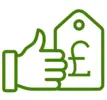The Rise of Clothing Banks
- By jon davis
- 28 Jun 2017

The Rise of Clothing Banks
You might have heard the mantra ‘reuse, repurpose, and recycle,’ or at least something similar, countless times now. The idea being that the more items we can reuse or recycle, the less items we send to landfill, and the more raw materials and energy we can conserve.
And clothing is no exception. We all probably have items that we no longer wear cluttering up our wardrobes, and that will no doubt end up in the bin when we get around to having a clear out. But if they are in good condition, there’s no need to throw them away.
What can you do with your old clothing?
- Donate them to a charity shop
- Donate them to a clothing bank
- Put them in the door to door charity collection bags
- Sell them on sites like eBay

The low down on clothing banks
You will have heard of food banks, but clothing banks? Here’s what you need to know about clothing banks:
Where are they located?
You will usually find them at recycling centres, and in supermarket car parks.
Are they secure?
Most are secure to stop people stealing items that are deposited.
Most have hinged loading chutes so you can deposit your goods, but that don’t allow you to gain access to what is already in the bin. The doors usually have strong locks or padlocks on them.
House-to-house collectors
Some charities carry out house to house collections for clothing and other goods. The main collectors are:
The Salvation Army which has over 5000 clothing banks in the UK.
British Heart Foundation
Oxfam
Scope

Where do the clothes go to?
Over half of the clothes are sent abroad to help less fortunate people, and some are sold in second-hand shops, and some go to charity shops in the UK.
Bag 2 School
Bag2School are a textile collection company that work with schools in the UK. They pay schools to collect clothing, so it’s diverted from landfill and sent to people who are in need. Since 1999, they have paid £27 million to schools, nurseries, and churches who have been involved in the collection scheme. The company can help schools to collect more clothes and therefore raise more funds, through tips on their website and through promotional materials.
How it works
When a school collects clothes, here’s how the Bag2School service works:
- A school that is registered with the scheme can easily arrange for the company to come and collect the clothes. The fleet of collection vehicles operates nationwide.
- The collected clothing is then weighed and schools are paid either on the day, or within a week. The company pay 40p for each kilogram of clothing collected.
- The clothes collected from each school are sorted into bales and then loaded onto trucks for export. Once they arrive at the factory, they are sorted into 150 different types of clothing.
- The clothing will then be sent all over the world. They could be sent to a second-hand store in Eastern Europe or South America, or to a market stall in East or West Africa. The clothes provide jobs for importers, and warehouse staff, as well as affordable clothes for local people who are in need.














